Click on images to enlarge

habit in spring (Photo: Sheldon Navie)

habit in flower in summer (Photo: Sheldon Navie)
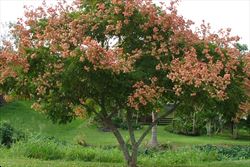
habit in fruit in autumn (Photo: Sheldon Navie)
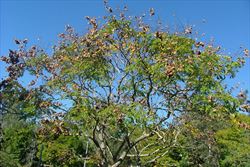
habit in winter (Photo: Sheldon Navie)
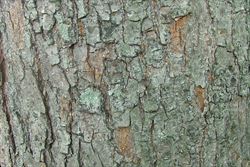
close-up of bark on main trunk (Photo: Sheldon Navie)
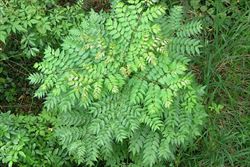
large twice-compound leaves (Photo: Sheldon Navie)

large branched flower clusters (Photo: Sheldon Navie)

close-up of flowers (Photo: Sheldon Navie)
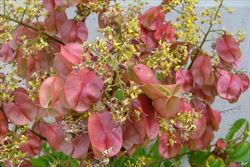
immature fruit (Photo: Sheldon Navie)
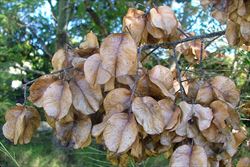
mature fruit (Photo: Sheldon Navie)
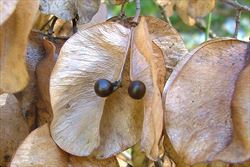
close-up of seeds (Photo: Sheldon Navie)

close-up of seedling (Photo: Sheldon Navie)
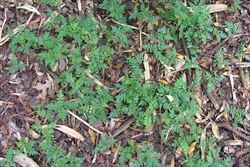
mass germination of seedlings under a parent tree (Photo: Sheldon Navie)
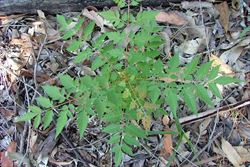
young plant (Photo: Sheldon Navie)

the very similar Koelreuteria paniculata, with once-compound leaves and slightly elongated fruit (Photo: Sheldon Navie)
Scientific Name
Koelreuteria elegans (Seem.) A.C. Sm. subsp. formosana (Hayata) F.G. Mey.
Synonyms
Koelreuteria elegans (Seem.) A.C. Sm.Koelreuteria formosana HayataKoelreuteria henryi Dumm.
Family
Sapindaceae
Common Names
Chinese flame tree, Chinese rain tree, flame gold, flame golden rain tree, flame golden rain-tree, flamegold, golden rain tree, golden raintree, golden-rain tree
Origin
Native to Taiwan.
Cultivation
Golden rain tree (Koelreuteria elegans subsp. formosana) has been widely cultivated as a garden ornamental and street tree, particularly in the warmer parts of Australia.
Naturalised Distribution
Locally naturalised in south-eastern Queensland (e.g. around Brisbane and near Noosa) and in the coastal districts of north-eastern New South Wales (e.g. near Lismore).
Also naturalised in south-eastern USA (i.e. Texas, Louisiana, Mississippi and Florida) and on some Pacific islands (i.e. Hawaii and Guam).
Habitat
A potential weed of roadsides, disturbed sites, waste areas, parks, urban bushland, riparian vegetation, gullies, forest margins and open woodlands in the sub-tropical, tropical and warmer temperate regions of Australia.
Habit
A medium-sized tree usually growing 5-12 m tall, but capable of reaching up to 25 m in height.
Distinguishing Features
- a medium-sized tree usually growing 5-12 m tall.
- its main trunk is covered in rough greyish-brown bark.
- its twice-compound leaves are very large (25-60 cm long and 15-44 cm wide) and have numerous leaflets (5.5-10 cm long).
- its large branched flower clusters (30-50 cm long) are borne at the tips of the branches in late spring or early summer.
- its bright yellow flowers (up to 2 cm across) usually have four or five yellow petals and the same number of stamens.
- its three-sided papery capsules pe (3.5-6 cm long) turn from bright red to pink and then eventually brown as they mature.
Stems and Leaves
The main trunk grows to about 50 cm across and is covered in rough greyish-brown bark that is furrowed lengthwise. Younger stems are pale brown or greenish in colour, finely hairy, and covered in small pale brown spots (i.e. lenticels).
The twice-compound (i.e. bipinnate) leaves are very large (25-60 cm long and 15-44 cm wide) and alternately arranged along the stems. These leaves are borne on stalks (i.e. petioles) and have several branches (i.e. pinnae), each carrying 8-17 leaflets (i.e. pinnules). The leaflets (5.5-10 cm long and 1.3-4 cm wide) are elongated to egg-shaped in outline (i.e. lanceolate to ovate) with entire to irregularly toothed (i.e. crenate or serrate) margins and long pointed tips (i.e. acuminate apices). They are mostly hairless (i.e. glabrous) or sparsely hairy (i.e. puberulent) and are either stalkless (i.e. sessile) or borne on tiny stalks (i.e. petiolules) up to 3 mm long.
Flowers and Fruit
The large, branched, flower clusters (30-50 cm long and 20-25 cm wide) are borne at the tips of the branches (i.e. they are terminal panicles). These clusters contain numerous yellow flowers (up to 2 cm across) with four or five green sepals and four or five (rarely six) bright yellow petals (5.5-7 mm long and 1.5-3.5 mm wide). Each flower is borne on a short stalk (i.e. pedicel) and has the same number of stamens (4.5-10 mm long) as petals. Flowering occurs for a relatively brief period during late spring or early summer each year.
The inflated papery capsules are three-sided in nature and somewhat oval (i.e. ellipsoidal) in shape (3.5-6 cm long and 2.5-4.5 cm wide). These fruit are initially bright red to deep rose-purple, but fade gradually to pink and eventually brown in colour as they mature. Each capsule usually contains six seeds (5.2-5.5 mm across), two in each of its papery compartments. These seeds are rounded (i.e. globose) to pear-shaped (i.e. pyriform), black in colour, and either smooth or slightly rough in texture. The fruit are mostly present during late summer and autumn, but some may persist on trees into winter.
Reproduction and Dispersal
Golden rain tree (Koelreuteria elegans subsp. formosana) reproduces by seed.
This species is generally spread to new areas by its deliberate cultivation. The seeds are blown from the trees still contained in their light and papery fruit (i.e. they are wind-dispersed) and may also be spread by water. They are probably also spread in dumped garden waste, while birds may also be a factor in their dispersal.
Environmental Impact
Golden rain tree (Koelreuteria elegans subsp. formosana) is regarded as an environmental weed in south-eastern Queensland and north-eastern New South Wales, and as a potential environmental weed in the Northern Territory and Western Australia. It is on the Alert List for Environmental Weeds, a list of 28 non-native plants that have the potential to seriously degrade Australia's ecosystems.
Legislation
Not declared or considered noxious by any state government authorities.
Similar Species
Golden rain tree (Koelreuteria elegans subsp. formosana) is very similar to another closely related species also known as golden rain trees (i.e. Koelreuteria paniculata). These species can be distinguished from each other by the following differences:
- Koelreuteria elegans subsp. formosana has twice-compound (i.e. bipinnate) leaves with relatively small leaflets (5.5-10 cm long) and oval-shaped (i.e. ellipsoid) fruit.
- Koelreuteria paniculata has once-compound (i.e. pinnate) leaves with relatively large leaflets (7-15 cm long) and slightly elongated fruit.

